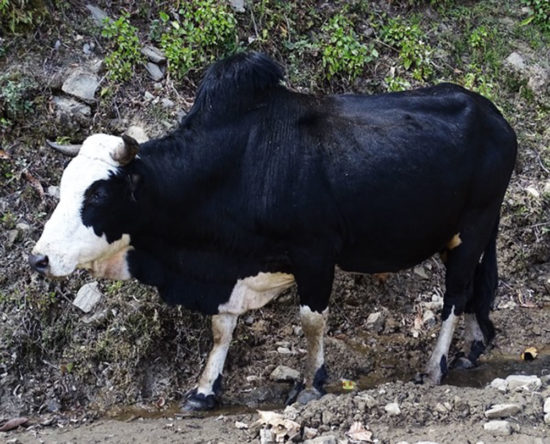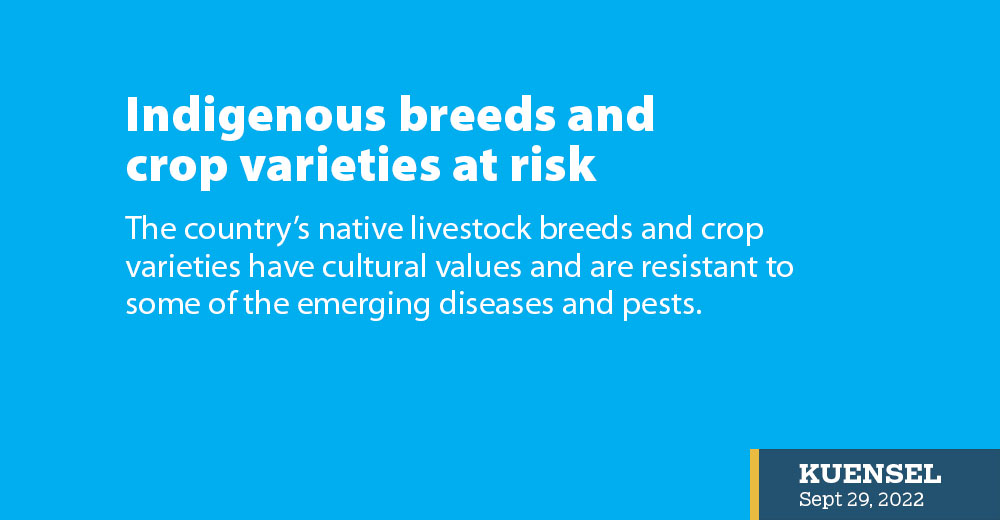Chhimi Dema
The country’s native livestock breeds and crop varieties have cultural values and are resistant to some of the emerging diseases and pests.
Records with the National Biodiversity Centre (NBC) show that there are 39 livestock breeds of eight different species, and 194 varieties of cereal consisting of rice, maize, wheat, barley, buckwheat, and millet in the country.
Today, with the switch from traditional agriculture systems to market-oriented cash crops, focus on rearing high-production livestock breeds and shortage of labour, among other factors, are threats to the indigenous livestock breeds and crop varieties.
There are 10 native breeds of poultry: Barred Yubja, Baylaitey, Belochem, Bobthra, Kauray, Naked Neck, Pulom, Shekheni, Yueja Naap, and Kaap in the country.
From the 10 breeds, NBC officials found that Baylaitey breed is disappearing.
Senior Biodiversity Officer at NBC, Tshering Dorji, said that it has been almost four years trying to find Baylaitey.
Some poultry breeds have cultural values. For example, Crested Belochem’s eggs were highly sought after by wealthy families in the olden days and in Southern Bhutan, Yueja Naap with its dark skin and thicker blood is said to have high nutritional value.
Tshering Dorji said that with commercialisation, people are giving up on native poultry for high-breed poultry which provides more production.
However, he said that there are farmers who are interested in rearing just local poultry because they have realised that the input is less.
The native species of poultry can fend for themselves and it was found that the birds are resistant to infectious bursal disease (IBD), a highly contagious, immunosuppressive disease of young chickens.
There is documentation of whole commercial birds getting wiped out with IBD but the native birds survived.
“The centre wants to focus on studying traits such as these of the native animals and prove it scientifically,” Tshering Dorji said.
Native sheep are disappearing fast with local communities facing shortage of labour and getting poor returns from the animal.
Tshering Dorji said: “The communities that rear sheep are abandoning the practice.”
There used to be two nomadic families along Dagala range rearing sheep and it was found that these families have now abandoned sheep-rearing.
The four native sheep found in Bhutan are in Jakar, Sibsoo, Sarpang, and Sakten type.
If households in areas where these sheep are found give up on the practice, the country loses the sheep’s genetic resources, Tshering Dorji said.
Efforts such as revamping the sheep breeding centre in Bumthang, developing a highland development programme, and focusing on sheep product development were made to encourage people to continue the practice.
Tshering Dorji said that the whole animal genetic resource is at risk. “Our calculations based on observation from the past two or three years is that by the next decade we will lose many of the native breed. If the current situation continues then we might lose in half a decade.”
NBC’s animal and gene banks are working on preserving these native breeds and varieties.
NBC’s biodiversity supervisor, Ugyen Phuntsho, said that NBC is trying to conserve the indigenous varieties before the country loses them forever.
NBC officials visiting the fields to collect assessions for the plant gene bank interact with the farmers and ask if there were previous varieties that they have not recorded.
Ugyen Phuntsho said that through the interaction, it seems that the country has lost many varieties already.
“We try to look for these crop varieties elsewhere and give it to the farmers who lost the variety,” he said.
People prefer high-yielding varieties of the crops for commercialisation, said Ugyen Phuntsho, adding that this puts the traditional varieties at risk of extinction.

Cattle
Nublang
Chicken
Barred Yuebja
Baylaitey
Belochem
Bobthra
Kauray
Naked Neck
Pulom
Shekheni
Yuebja Naap
Yuebja kaap
Horse
Boeta
Merak Saktenpata
Sharta
Yuta
Pig
Doemphab
Jituphab/Saphag
Sheep
Jakar
Sakten
Sarpang
Sipsu
Yak
Eastern Yak
Western yak


